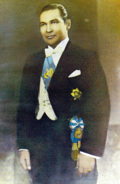Fulgencio Batista
Fulgencio Batista y Zaldívar (January 16, 1901 – August 6, 1973) was the military leader of Cuba from 1933 to 1940. He was a farm worker from eastern Cuba, and moved to Havana where he became a stenographer and a sergeant in the Army. He became a leader of a group of sergeants who wanted better pay. With others they overthrew President Gerardo Machado in 1933 and Batista ended up commanding the Army.
Fulgencio Batista | |
|---|---|
 Batista in 1938 | |
| 14th Prime Minister of the Republic of Cuba | |
| In office March 10, 1952 – January 1, 1959 | |
| Prime Minister | See list
|
| Vice President | Rafael Guas Inclán |
| Preceded by | Carlos Prío Socarrás |
| Succeeded by | Anselmo Alliegro |
| In office October 10, 1940 – October 10, 1944 | |
| Prime Minister |
|
| Vice President | Gustavo Cuervo Rubio |
| Preceded by | Federico Laredo Brú |
| Succeeded by | Ramón Grau |
| Prime Minister of Cuba | |
| In office 10 March 1952 – 4 April 1952 | |
| President | Himself |
| Preceded by | Óscar Gans |
| Succeeded by |
|
| Cuban Senator | |
| In office June 2, 1948 – March 10, 1952 | |
| Constituency | Las Villas |
| Personal details | |
| Born | Rubén Zaldívar January 16, 1901 Banes, Cuba |
| Died | August 6, 1973 (aged 72) Marbella, Málaga, Spain |
| Resting place | Saint Isidore Cemetery |
| Political party | |
| Spouse(s) | |
| Children | 9 |
| Other names | Fulgencio Batista y Zaldívar (full name from 1939) |
| Military service | |
| Allegiance | Republic of Cuba |
| Branch/service | Cuban Army |
| Years of service | 1921–1940 |
| Rank | Major general |
In 1940 Batista won election and was President of Cuba until 1944. In 1952 he made his own coup and ruled the country until 1959. His authoritarian government during this time caused opposition despite his attempt to placate critics with a 'show' election in 1954 where he ran without opposition. The opposition included the entire coalition that had overthrown Gerardo Machado.
Fidel Castro's guerrilla movement overthrew Batista. This is known as the Cuban Revolution. Batista fled Cuba on January 1, 1959 and went to the Dominican Republic before moving on to Portugal, and finally to Spain where he died of a heart attack in 1973.
Fulgencio Batista Media
Batista (left) with his first wife Elisa Godinez-Gómez on a 1938 visit to Washington, D.C., greeting the Cuban ambassador, Pedro Fraga
Slum (bohio) dwellings in Havana, Cuba, in 1954, just outside Havana baseball stadium. In the background is advertising for a nearby casino.
Batista's Golden Telephone is now in Havana's Museum of the Revolution as a symbol of Batista era corruption.
Batista with U.S. Army Chief of staff Malin Craig in Washington, D.C., riding in an Armistice Day parade, 1938
Batista in March 1957, standing next to a map of the Sierra Maestra mountains where Fidel Castro's rebels were based
Batista and his wife Marta Fernández Miranda at breakfast in the Presidential Palace in April 1958








